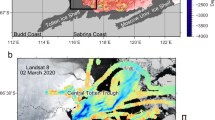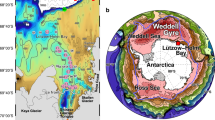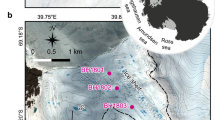Abstract
Totten Glacier, the primary outlet of the Aurora Subglacial Basin, has the largest thinning rate in East Antarctica1,2. Thinning may be driven by enhanced basal melting due to ocean processes3, modulated by polynya activity4,5. Warm modified Circumpolar Deep Water, which has been linked to glacier retreat in West Antarctica6, has been observed in summer and winter on the nearby continental shelf beneath 400 to 500 m of cool Antarctic Surface Water7,8. Here we derive the bathymetry of the sea floor in the region from gravity9 and magnetics10 data as well as ice-thickness measurements11. We identify entrances to the ice-shelf cavity below depths of 400 to 500 m that could allow intrusions of warm water if the vertical structure of inflow is similar to nearby observations. Radar sounding reveals a previously unknown inland trough that connects the main ice-shelf cavity to the ocean. If thinning trends continue, a larger water body over the trough could potentially allow more warm water into the cavity, which may, eventually, lead to destabilization of the low-lying region between Totten Glacier and the similarly deep glacier flowing into the Reynolds Trough. We estimate that at least 3.5 m of eustatic sea level potential drains through Totten Glacier, so coastal processes in this area could have global consequences.
This is a preview of subscription content, access via your institution
Access options
Subscribe to this journal
Receive 12 print issues and online access
$259.00 per year
only $21.58 per issue
Buy this article
- Purchase on Springer Link
- Instant access to full article PDF
Prices may be subject to local taxes which are calculated during checkout



Similar content being viewed by others
References
Flament, T. & Rémy, F. Dynamic thinning of Antarctic glaciers from along-track repeat radar altimetry. J. Glaciol. 58, 830–840 (2012).
Pritchard, H. D., Arthern, R. J., Vaughan, D. G. & Edwards, L. A. Extensive dynamic thinning on the margins of the Greenland and Antarctic ice sheets. Nature 461, 971–975 (2009).
Pritchard, H. D. et al. Antarctic ice-sheet loss driven by basal melting of ice shelves. Nature 484, 502–505 (2012).
Gwyther, D. E., Galton-Fenzi, B. K., Hunter, J. R. & Roberts, J. L. Simulated melt rates for the Totten and Dalton ice shelves. Ocean Sci. Discuss. 10, 2109–2140 (2013).
Khazendar, A. et al. Observed thinning of Totten Glacier is linked to coastal polynya variability. Nature Commun. 4, 2857 (2013).
Jenkins, A. et al. Observations beneath Pine Island Glacier in West Antarctica and implications for its retreat. Nature Geosci. 3, 468–472 (2010).
Bindoff, N. L., Rosenberg, M. A. & Warner, M. J. On the circulation and water masses over the Antarctic continental slope and rise between 80 and 150° E. Deep Sea Res. 47, 2299–2326 (2000).
Williams, G. D. et al. Late winter oceanography off the Sabrina and BANZARE coast (117–128° E), East Antarctica. Deep Sea Res. 58, 1194–1210 (2011).
Parker, R. L. The rapid calculation of potential anomalies. Geophys. J. R. Astron. Soc. 31, 447–455 (1973).
Aitken, A. R. A. et al. The subglacial geology of Wilkes Land, East Antarctica. Geophys. Res. Lett. 41, 2390–2400 (2014).
Young, D. A. et al. A dynamic early East Antarctic Ice Sheet suggested by ice-covered fjord landscapes. Nature 474, 72–75 (2011).
Pollard, D., DeConto, R. M. & Alley, R. B. Potential Antarctic Ice Sheet retreat driven by hydrofracturing and ice cliff failure. Earth Planet. Sci. Lett. 412, 112–121 (2015).
Galton-Fenzi, B., Maraldi, C., Coleman, R. & Hunter, J. The cavity under the Amery Ice Shelf, East Antarctica. J. Glaciol. 54, 881–887 (2008).
Rignot, E., Mouginot, J. & Scheuchl, B. Antarctic grounding line mapping from differential satellite radar interferometry. Geophys. Res. Lett. 38, L10504 (2011).
Bohlander, J. & Scambos, T. Antarctic Coastlines and Grounding Line Derived from MODIS Mosaic of Antarctica (MOA) (National Snow and Ice Data Center, 2007); http://nsidc.org/data/atlas/news/antarctic_coastlines.html
Bindschadler, R., Vaughan, D. G. & Vornberger, P. Variability of basal melt beneath the Pine Island Glacier Ice Shelf, West Antarctica. J. Glaciol. 57, 581–595 (2011).
Van den Broeke, M. Depth and density of the Antarctic firn layer. Arct. Antarct. Alp. Res. 40, 432–438 (2008).
Scambos, T. A., Haran, T. M., Fahnestock, M. A., Painter, T. H. & Bohlander, J. MODIS-based Mosaic of Antarctica (MOA) data sets: Continent-wide surface morphology and snow grain size. Remote Sens. Environ. 111, 242–257 (2007).
Neal, C. Radio echo determination of basal roughness characteristics on the Ross Ice Shelf. Ann. Glaciol. 3, 216–221 (1982).
Van Beek, L. Dielectric behaviour of heterogeneous systems. Prog. Dielectr. 7, 69–114 (1967).
Peters, M. E., Blankenship, D. D. & Morse, D. L. Analysis techniques for coherent airborne radar sounding: Application to West Antarctic ice streams. J. Geophys. Res. 110, B06303 (2005).
Schroeder, D. M., Blankenship, D. D. & Young, D. A. Evidence for a water system transition beneath Thwaites Glacier, West Antarctica. Proc. Natl Acad. Sci. USA 110, 12225–12228 (2013).
Holdsworth, G. Flexure of a floating ice tongue. J. Glaciol. 8, 385–397 (1969).
Vaughan, D. G. Tidal flexure at ice shelf margins. J. Geophys. Res. 100, 6213–6224 (1995).
Rignot, E. Mass balance of East Antarctic glaciers and ice shelves from satellite data. Ann. Glaciol. 34, 217–227 (2002).
Fretwell, P. et al. Bedmap2: Improved ice bed, surface and thickness datasets for Antarctica. Cryosphere 7, 375–393 (2013).
Arndt, J. E. et al. The International Bathymetric Chart of the Southern Ocean (IBCSO) Version 1.0—A new bathymetric compilation covering circum-Antarctic waters. Geophys. Res. Lett. 40, 3111–3117 (2013)
Chen, J. L., Wilson, C. R., Blankenship, D. & Tapley, B. D. Accelerated Antarctic ice loss from satellite gravity measurements. Nature Geosci. 2, 859–862 (2009)
Bamber, J. L., Riva, R. E. M., Vermeersen, B. L. A. & LeBrocq, A. M. Reassessment of the potential sea-level rise from a collapse of the West Antarctic Ice Sheet. Science 324, 901–903 (2009).
Young, D. A. et al. Land-ice elevation changes from photon-counting swath altimetry: First applications over the Antarctic Ice Sheet. J. Glaciol. 61, 17–28 (2015).
Acknowledgements
This project is the result of the ongoing ICECAP collaboration between the USA, UK and Australia with support from NSF grants PLR-0733025 and PLR-1143843, and CDI-0941678, NASA grants NNG10HPO6C and NNX11AD33G (Operation Ice Bridge and the American Recovery and Reinvestment Act), Australian Antarctic Division projects 3013 and 4077, NERC grant NE/D003733/1, the G. Unger Vetlesen Foundation, the Jackson School of Geosciences, and the Antarctic Climate and Ecosystems Cooperative Research Centre. We thank the captains and crews of Kenn Borek Airlines Ltd, ICECAP project participants, CMG Operations Pty Ltd, and the Geosoft Education Program. We also thank S. Kempf for assistance with radar data processing, as well as A. Leventer, A. Wåhlin, D. Gwyther, K. Soderlund, C. Grima, F. Habbal and S. Zedler for comments on the manuscript. Part of the research was carried out at the Jet Propulsion Laboratory, California Institute of Technology, under a contract with the National Aeronautics and Space Administration. This is UTIG contribution 2831.
Author information
Authors and Affiliations
Contributions
J.S.G. performed the gravity inversions, magnetic depth to basement estimates, hydrostatic analysis, applied the bed reflectivity corrections, and wrote the manuscript. D.D.B., D.A.Y. and A.R.A.A. assisted with the potential field interpretations. J.S.G. and T.G.R. performed the initial gravity reduction and J.S.G. levelled the result. J.L.R. estimated the sea level potential for Totten Glacier. B.L. computed the percentage deflection expected for a range of trough widths and commented on what would be detectable using existing ERS data. D.M.S. provided radar technical and interpretation guidance for the discussion of reflectivity and specularity. A.R.A.A. performed the magnetics data reduction. J.L.R., R.C.W. and T.D.v.O. provided the glaciological context for Totten Glacier. J.S.G., D.A.Y., D.D.B., T.D.v.O., J.L.R., M.J.S. and R.C.W. designed the surveys. J.S.G., D.A.Y., T.D.v.O., J.L.R. and R.C.W. collected the data. All authors contributed comments to the interpretation of results and preparation of the final paper.
Corresponding author
Ethics declarations
Competing interests
The authors declare no competing financial interests.
Supplementary information
Supplementary Information
Supplementary Information (PDF 2340 kb)
Rights and permissions
About this article
Cite this article
Greenbaum, J., Blankenship, D., Young, D. et al. Ocean access to a cavity beneath Totten Glacier in East Antarctica. Nature Geosci 8, 294–298 (2015). https://doi.org/10.1038/ngeo2388
Received:
Accepted:
Published:
Issue Date:
DOI: https://doi.org/10.1038/ngeo2388
This article is cited by
-
Satellite record reveals 1960s acceleration of Totten Ice Shelf in East Antarctica
Nature Communications (2023)
-
On-shelf circulation of warm water toward the Totten Ice Shelf in East Antarctica
Nature Communications (2023)
-
Response of the East Antarctic Ice Sheet to past and future climate change
Nature (2022)
-
Poleward eddy-induced warm water transport across a shelf break off Totten Ice Shelf, East Antarctica
Communications Earth & Environment (2021)
-
Deep glacial troughs and stabilizing ridges unveiled beneath the margins of the Antarctic ice sheet
Nature Geoscience (2020)



